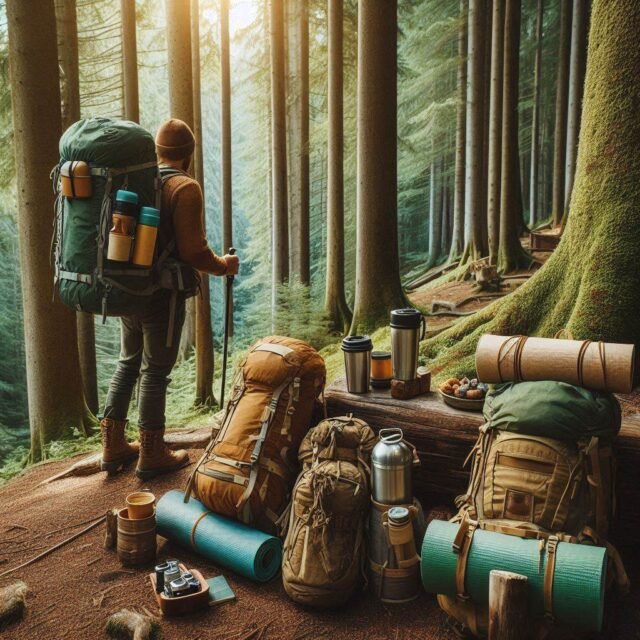Table of Contents
Sustainable Gear, Epic Adventures: Hike, Camp, Climb with a Lighter Footprint
The call of the wild has never been stronger. As more people seek solace and adventure in nature, there’s a growing awareness of our impact on the very environments we cherish. Enter the world of sustainable outdoor gear – a realm where innovation meets responsibility, allowing us to explore the great outdoors while treading lightly on the planet.
This comprehensive 2024 Outdoor Tech Lab guide will equip you with the knowledge to make eco-conscious choices, from selecting top brands to extending the lifespan of your gear, ensuring your adventures are as kind to the earth as they are thrilling to your spirit.
The Rise of Eco-Conscious Adventuring
The outdoor industry has undergone a significant shift in recent years. No longer is it enough for gear to be merely functional; it must also align with the values of environmental stewardship.
This change is driven by both consumer demand and a genuine desire within the industry to protect the natural spaces that are fundamental to outdoor recreation.
Sustainability in outdoor gear encompasses several key aspects:
1. Responsible material sourcing
2. Ethical manufacturing processes
3. Durability and longevity of products
4. End-of-life considerations (recyclability, biodegradability)
5. Reduced environmental impact throughout the product lifecycle

Leaders in Sustainable Practices
Many outdoor gear companies are stepping up to the challenge, integrating sustainability into the core of their business models. Let’s explore some of the brands leading this green revolution:
Nemo: Innovating for a Lighter Footprint
Known for their innovative and ultralight tents, Nemo has made sustainability a cornerstone of their brand identity. Their “Endless Promise®” collection showcases their commitment to eco-friendly design:
– Fully recyclable materials: Tents and sleeping bags designed for easy disassembly and recycling at the end of their useful life.
– Recycled content: Extensive use of recycled fabrics and fills across their product lines.
– Transparency: Annual sustainability reports detailing their progress and future goals.
Nemo’s approach demonstrates that cutting-edge gear and environmental responsibility can go hand in hand. Their ultralight designs not only reduce the physical burden on hikers but also minimize the resources required for production and transportation.
Cotopaxi: Gear for Good
With their vibrant designs and socially conscious ethos, Cotopaxi has carved out a unique niche in the outdoor industry. Their commitment to sustainability extends beyond materials:
– Recycled and repurposed materials: Many of their popular backpacks and outerwear items incorporate fabric scraps and remnants, reducing waste.
– Social impact: A portion of every sale supports social and environmental initiatives worldwide.
– Lifetime warranty: Encouraging long-term use and reducing the need for replacements.
Cotopaxi’s approach reminds us that sustainability isn’t just about materials – it’s about fostering a holistic relationship between people, products, and the planet.
The North Face: A Giant Embraces Green
As one of the most recognizable names in outdoor gear, The North Face’s commitment to sustainability has far-reaching implications for the industry. Their efforts include:
– “Green Label” products: A dedicated line featuring recycled materials and eco-friendly manufacturing processes.
– PFC-free water repellency: Developing alternatives to harmful perfluorinated compounds traditionally used in waterproof gear.
– Renewed program: Refurbishing and reselling used gear to extend product lifecycles.
The North Face’s size and influence make their sustainability initiatives particularly impactful, potentially driving change throughout the supply chain and inspiring other large brands to follow suit.
Beyond Brands: The Key to Truly Sustainable Gear
While brand reputation is a good starting point, truly sustainable outdoor gear choices require a deeper understanding of what makes a product environmentally friendly. Here are the key factors to consider:
Durability: The Cornerstone of Sustainability
The most sustainable gear is the gear you don’t have to replace. When shopping for outdoor equipment, prioritize durability:
– Look for robust construction: Reinforced seams, bar tacking at stress points, and high-quality zippers are all indicators of gear built to last.
– Research materials: Some fabrics, like ripstop nylon or high-density polyester, offer superior tear and abrasion resistance.
– Read reviews: Look for long-term user experiences to gauge how well gear holds up over time.
Investing in durable gear may have a higher upfront cost, but it pays dividends in longevity and reduced environmental impact over time.

Material Matters: Choosing Earth-Friendly Fabrics
The materials used in outdoor gear have a significant impact on its overall sustainability:
Natural Fibers:
– Merino wool: Renewable, biodegradable, and naturally odor-resistant.
– Organic cotton: Grown without harmful pesticides, reducing environmental toxins.
– Hemp: Requires minimal water and no pesticides to grow, plus it’s incredibly durable.
Recycled Synthetics:
– Recycled polyester: Often made from post-consumer plastic bottles, reducing landfill waste and petroleum use.
– Recycled nylon: Diverts waste from landfills and requires less energy to produce than virgin nylon.
Innovative Eco-Materials:
– Tencel/Lyocell: Made from sustainably harvested wood pulp, biodegradable, and requires less water to produce than cotton.
– Bio-based synthetics: Derived from renewable resources like castor beans or corn, reducing reliance on petroleum.
When evaluating materials, consider not just their origin but also their performance characteristics and end-of-life impact.
Versatility: Do More with Less
Multifunctional gear reduces the overall number of items you need, lowering your environmental footprint:
– Convertible clothing: Pants that zip off into shorts, or jackets with removable layers, adapt to various conditions.
– Modular systems: Backpacks with detachable daypacks or sleeping bags with removable liners offer flexibility.
– All-season gear: Look for items designed to perform well across a range of temperatures and conditions.
By choosing versatile gear, you not only reduce waste but also simplify your packing and potentially save money in the long run.

Gear Care: Extending the Lifespan of Your Equipment
Proper care and maintenance are crucial for maximizing the lifespan of your outdoor gear, reducing the need for replacements and minimizing waste. Here are some essential tips:
Cleaning with Care
– Follow manufacturer instructions: Different materials require different cleaning approaches. Always check the care label.
– Use appropriate cleaning products: Harsh detergents can damage waterproof coatings or compromise insulation. Opt for specialized cleaners designed for outdoor gear.
– Spot clean when possible: Address small stains or dirt patches individually to avoid unnecessary full washes.
Regular Maintenance
– Reapply DWR (Durable Water Repellent) coatings: This maintains the water-shedding ability of your waterproof gear.
– Lubricate zippers: A simple step that prevents wear and extends the life of this crucial component.
– Patch and repair promptly: Address small tears or loose seams immediately to prevent further damage.
Proper Storage
– Clean and dry thoroughly: Never store gear when it’s damp or dirty.
– Use appropriate storage methods: Hang clothing to prevent creases, use breathable bags for tents and sleeping bags, and store boots with shoe trees to maintain their shape.
– Avoid direct sunlight and extreme temperatures: UV rays and heat can degrade materials over time.
By implementing these care practices, you’ll not only extend the life of your gear but also maintain its performance, ensuring it’s ready for your next adventure.
The Circular Economy: What to Do When Gear Reaches the End
Even the most well-cared-for gear eventually wears out. When that time comes, consider these sustainable options:
Repair and Upcycle
– DIY repairs: Many outdoor brands offer repair kits or guides for common issues.
– Professional repair services: Some companies, like Patagonia’s Worn Wear program, offer repair services to extend gear life.
– Upcycling projects: Transform old gear into new, useful items (e.g., tent fabric into stuff sacks, old ropes into rugs).
Responsible Disposal
– Brand take-back programs: Many outdoor companies now offer to recycle your old gear, sometimes offering discounts on new purchases.
– Textile recycling: Seek out local textile recycling programs for items that can’t be repaired or upcycled.
– Donation: Usable gear can find new life through outdoor education programs or gear libraries.

Frequently Asked Questions on Sustainable Outdoor Gear
Q: Are there any downsides to sustainable gear?
A: While sustainable gear often performs on par with conventional alternatives, there can be some considerations:
– Cost: Eco-friendly materials and ethical manufacturing processes can sometimes result in higher prices. However, the durability of these products often provides better value over time.
– Limited options: The range of sustainable gear is growing but may still be more limited compared to conventional options in some categories.
– Performance trade-offs: In some cases, sustainable materials may have slightly different performance characteristics. For example, some recycled fabrics might not be quite as light as their virgin counterparts.
It’s important to weigh these factors against the environmental benefits and your personal priorities.
Q: How can I find good deals on sustainable gear?
A: Sustainable doesn’t have to mean expensive. Try these strategies:
– Look for brand-specific used gear sales: Many sustainable outdoor brands now offer refurbished or gently used items at a discount.
– Explore online marketplaces: Websites like REI’s Used Gear, Patagonia Worn Wear, or GearTrade specialize in pre-loved outdoor equipment.
– Subscribe to brand newsletters: Many companies offer exclusive discounts to email subscribers, especially during off-seasons.
– Consider last season’s models: Performance doesn’t change much year-to-year, but prices often drop significantly on older stock.
Q: What can I do with old, unusable gear?
A: Even gear that’s no longer fit for the trail can avoid the landfill:
– Check for brand take-back programs: Many outdoor companies now offer recycling programs for their products, sometimes with incentives.
– Explore local recycling options: Some materials, like certain synthetic fabrics, can be recycled through specialized programs.
– Get creative with upcycling: Old gear can be transformed into everything from organizers to pet toys. Online communities often share innovative ideas for repurposing gear.
– Donate to artists or schools: Unusable gear can find new life as material for art projects or educational demonstrations.

Embracing the Sustainable Outdoor Lifestyle
Choosing sustainable outdoor gear is more than a purchasing decision – it’s a commitment to preserving the natural world we love to explore. By investing in durable, eco-friendly equipment, practicing proper care and maintenance, and considering the full lifecycle of our gear, we can significantly reduce our environmental impact.
Remember, sustainability is a journey, not a destination. It’s okay to make changes gradually, replacing items with more sustainable options as your current gear wears out.
Every choice matters, and collectively, our decisions as outdoor enthusiasts can drive significant positive change in the industry and beyond.
So, as you prepare for your next adventure, consider not just where you’re going, but how your gear choices impact the world around you. With the right equipment and mindset, you can tread lightly on the earth while exploring its deepest wonders.
The trails await – let’s hit them responsibly, leaving nothing but footprints and taking nothing but memories and a renewed commitment to protecting our planet’s wild spaces.
Resource:

Introducing JC – The Outdoor Gear Enthusiast and Tester behind Outdoor Tech Lab:
Dive into the exciting world of outdoor gear technology with JC, the founder and driving force behind Outdoor Tech Lab.
With a passion for backpacking, nature and a knack for outdoors gadgets, JC has embarked on a mission to help others explore the outdoors in smarter, safer, and more enjoyable ways.
Join us on the adventure as we explore the ever-evolving landscape of outdoor gear & technology.
Through insightful reviews, practical tips, testing and engaging stories, Outdoor Tech Lab is your one-stop shop for navigating the wild world of outdoor gadgets and gear in 2024 and beyond.





Leave a Reply